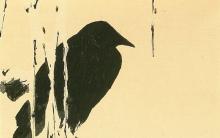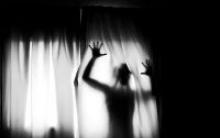The great Japanese poet Matsuo Basho was born in the castle town of Ueno into the family of a poor samurai.
The poet's hometown was in the province of Iga - in the very cradle of Japanese culture, in the center of the main island - Honshu. Many places in Basho’s homeland were known for their beauty, and folk memory preserved songs, legends, and ancient customs there in abundance. Since childhood, Basho began to write poetry. In his youth, he became a monk, thereby freeing himself from serving the feudal lord. But Basho did not become a real monk. In his travels, he walked along the roads of Japan, as an ambassador of poetry itself, igniting in people a love for it, introducing people to true art.
Basho raised the genre of folk poetry - haiku - to unattainable heights. The art of writing haiku is, first of all, the ability to say a lot in a little, to say it in such a way as to infect the reader with lyrical excitement and awaken his imagination. The main theme of Basho's tercet is nature. His tercets, like magic binoculars, help to see familiar pictures anew, to realize the uniqueness and grandeur of the natural world - from the modest colza flower to the Milky Way. In three lines, Basho was able to show the endless expanses of the Sea of Japan, the shine of the stars on a clear autumn night, the white breakers on the waves and the black silhouette of Sado Island at the edge of the sky:
The sea is raging! Far away, to Sado Island, the Milky Way spreads.
Basho invites us to take a fresh look at a painting that we have seen perhaps dozens of times:
Take a close look! You will see the flowers of the shepherd's purse under the fence.
All living things are unique and priceless. Not only the many times sung cherry blossoms and autumn beauties - chrysanthemums, are beautiful, but also roadside loaches, wild ivy and raindrops hanging on motionless branches.
Basho’s nature lives its own unique life, but it is so similar to human life! In haiku, “birds are crying and the eyes of fish are full of tears” because spring is leaving, two stars are celebrating their meeting, and a chilled monkey asks for a straw cloak, a seagull is freezing, standing in cold water, and flowers accomplish “their highest feat” with unique blooms.
The poet knows how to not only paint a poetic, vivid picture in a few precise words, but also convey the essence of a natural phenomenon, feel the mood of a tree, butterfly, bird, wind, autumn:
A lonely raven sits on a bare branch. Autumn evening.
It is difficult to imagine a more poignant picture of late autumn with its sadness, loneliness and black and white colors.
Reading Basho’s poems, you involuntarily agree with the poet that a person doesn’t need much to be happy: Material from the site
A secluded house. Moon... Chrysanthemums... In addition to them, a piece of a small field.
The lyrical hero of Basho's poetry is an unassuming man, but wise and subtle. This is a poet and philosopher in love with the nature of his native country. He is inseparable from his era and people. In every small haiku you can feel the breath of a huge world. In one of the three lines, Basho seems to be addressing the hasty reader who opened the book of haiku for the first time.
Matsuo Basho. Engraving by Tsukioka Yoshitoshi from the series “101 Views of the Moon.” 1891 The Library of Congress
Genre haiku originated from another classical genre - pentaverse tank in 31 syllables, known since the 8th century. There was a caesura in the tanka, at this point it “broke” into two parts, resulting in a tercet of 17 syllables and a couplet of 14 syllables - a kind of dialogue, which was often composed by two authors. This original tercet was called haiku, which literally means "initial stanzas". Then, when the tercet received its own meaning and became a genre with its own complex laws, it began to be called haiku.
The Japanese genius finds himself in brevity. Haiku tercet is the most laconic genre of Japanese poetry: only 17 syllables of 5-7-5 mor. Mora- a unit of measurement for the number (longitude) of a foot. Mora is the time required to pronounce a short syllable. in line. There are only three or four significant words in a 17-syllable poem. In Japanese, a haiku is written in one line from top to bottom. In European languages, haiku is written in three lines. Japanese poetry does not know rhymes; by the 9th century, the phonetics of the Japanese language had developed, including only 5 vowels (a, i, u, e, o) and 10 consonants (except for voiced ones). With such phonetic poverty, no interesting rhyme is possible. Formally, the poem is based on the count of syllables.
Until the 17th century, haiku writing was viewed as a game. Hai-ku became a serious genre with the appearance of the poet Matsuo Basho on the literary scene. In 1681, he wrote the famous poem about the crow and completely changed the world of haiku:
On a dead branch
The raven turns black.
Autumn evening. Translation by Konstantin Balmont.
Let us note that the Russian symbolist of the older generation, Konstantin Balmont, in this translation replaced the “dry” branch with a “dead” one, excessively, according to the laws of Japanese versification, dramatizing this poem. The translation turns out to violate the rule of avoiding evaluative words and definitions in general, except for the most ordinary ones. "Words of Haiku" ( haigo) should be distinguished by deliberate, precisely calibrated simplicity, difficult to achieve, but clearly felt insipidity. Nevertheless, this translation correctly conveys the atmosphere created by Basho in this haiku, which has become a classic, the melancholy of loneliness, the universal sadness.
There is another translation of this poem:
Here the translator added the word “lonely,” which is not in the Japanese text, but its inclusion is nevertheless justified, since “sad loneliness on an autumn evening” is the main theme of this haiku. Both translations are rated very highly by critics.
However, it is obvious that the poem is even simpler than the translators presented. If you give its literal translation and place it in one line, as the Japanese write haiku, you will get the following extremely short statement:
枯れ枝にからすのとまりけるや秋の暮れ
On a dry branch / a raven sits / autumn twilight
As we can see, the word “black” is missing in the original, it is only implied. The image of a “chilled raven on a bare tree” is Chinese in origin. "Autumn Twilight" ( aki no kure) can be interpreted both as “late autumn” and as “autumn evening”. Monochrome is a quality highly valued in the art of haiku; depicts the time of day and year, erasing all colors.
Haiku is least of all a description. It is necessary not to describe, the classics said, but to name things (literally “to give names to things” - to the hole) in extremely simple words and as if you were calling them for the first time.
 Raven on a winter branch. Engraving by Watanabe Seitei. Around 1900 ukiyo-e.org
Raven on a winter branch. Engraving by Watanabe Seitei. Around 1900 ukiyo-e.org Haiku are not miniatures, as they were long called in Europe. The greatest haiku poet of the late nineteenth and early twentieth centuries, who died early from tuberculosis, Masaoka Shiki, wrote that haiku contains the whole world: the raging ocean, earthquakes, typhoons, the sky and stars - the whole earth with the highest peaks and the deepest sea depressions. The space of haiku is immense, infinite. In addition, haiku tends to be combined into cycles, into poetic diaries - and often life-long, so that the brevity of haiku can turn into its opposite: into long works - collections of poems (though of a discrete, intermittent nature ).
But the passage of time, past and future X does not depict aiku, haiku is a brief moment of the present - and nothing more. Here is an example of a haiku by Issa, perhaps the most beloved poet in Japan:
How the cherry blossomed!
She drove off her horse
And a proud prince.
Transience is an immanent property of life in the Japanese understanding; without it, life has no value or meaning. Fleetingness is both beautiful and sad because its nature is fickle and changeable.
An important place in haiku poetry is the connection with the four seasons - autumn, winter, spring and summer. The sages said: “He who has seen the seasons has seen everything.” That is, I saw birth, growing up, love, rebirth and death. Therefore, in classical haiku, a necessary element is the “seasonal word” ( kigo), which connects the poem with the season. Sometimes these words are difficult for foreigners to recognize, but the Japanese know them all. Detailed kigo databases, some of thousands of words, are now being searched on Japanese networks.
In the above haiku about the crow, the seasonal word is very simple - "autumn." The coloring of this poem is very dark, emphasized by the atmosphere of an autumn evening, literally “autumn twilight,” that is, black against the background of deepening twilight.
Look how gracefully Basho introduces the essential sign of the season into a poem about separation:
For a spike of barley
I grabbed, looking for support...
How difficult is the moment of separation!
“A spike of barley” directly indicates the end of summer.
Or in the tragic poem of the poetess Chiyo-ni on the death of her little son:
O my dragonfly catcher!
Where in an unknown country
Did you run in today?
"Dragonfly" is a seasonal word for summer.
Another “summer” poem by Basho:
Summer herbs!
Here they are, the fallen warriors
Dreams of glory...
Basho is called the poet of wanderings: he wandered a lot around Japan in search of true haiku, and, when setting off, he did not care about food, lodging, tramps, or the vicissitudes of the path in the remote mountains. On the way, he was accompanied by the fear of death. A sign of this fear was the image of “Bones Whitening in the Field” - this was the name of the first book of his poetic diary, written in the genre haibun(“prose in haiku style”):
Maybe my bones
The wind will whiten... It's in the heart
It breathed cold on me.
After Basho, the theme of “death on the way” became canonical. Here is his last poem, “The Dying Song”:
I got sick on the way,
And everything runs and circles my dream
Through scorched fields.
Imitating Basho, haiku poets always composed “last stanzas” before they died.
"True" ( Makoto-no) the poems of Basho, Buson, Issa are close to our contemporaries. The historical distance is, as it were, removed in them due to the immutability of the haiku language, its formulaic nature, which has been preserved throughout the history of the genre from the 15th century to the present day.
The main thing in the worldview of a haikaist is an acute personal interest in the form of things, their essence, and connections. Let us remember the words of Basho: “Learn from the pine tree what pine is, learn from bamboo what bamboo is.” Japanese poets cultivated meditative contemplation of nature, peering into the objects surrounding a person in the world, into the endless cycle of things in nature, into its bodily, sensual features. The poet's goal is to observe nature and intuitively discern its connections with the human world; haikaists rejected ugliness, pointlessness, utilitarianism, and abstraction.
Basho created not only haiku poetry and haibun prose, but also the image of a poet-wanderer - a noble man, outwardly ascetic, in a poor dress, far from everything worldly, but also aware of the sad involvement in everything happening in the world, preaching conscious “simplification”. The haiku poet is characterized by an obsession with wandering, the Zen Buddhist ability to embody the great in the small, awareness of the frailty of the world, the fragility and changeability of life, the loneliness of man in the universe, the tart bitterness of existence, a sense of the inseparability of nature and man, hypersensitivity to all natural phenomena and the change of seasons .
The ideal of such a person is poverty, simplicity, sincerity, a state of spiritual concentration necessary to comprehend things, but also lightness, transparency of verse, the ability to depict the eternal in the current.
At the end of these notes, we present two poems by Issa, a poet who treated with tenderness everything small, fragile, and defenseless:
Quietly, quietly crawl,
Snail, on the slope of Fuji,
Up to the very heights!Hiding under the bridge,
Sleeping on a snowy winter night
Homeless child.
Goal: To introduce students to M. Basho’s poetry, its peculiarities, and to help them perceive Japanese poetry, which is unusual for us. To evoke a response in the hearts of children to what was close to the poet, to what he wrote about.
Equipment – Portrait of a poet. Illustrations from the engraver L.A. Ilyina, graphic artist.
DURING THE CLASSES
1. Updating students' knowledge. Checking homework (Biography of M. Basho)
2. Teacher’s word: In the last lesson we got acquainted with the life and creative path of the Japanese poet M. Basho. You are already familiar with many poets. Each of you perceives their creativity in your own way. And each of you already has, albeit small, your own life experience, and your heart responds to what is close to it. Today we will try to make your hearts respond to the poetry of M. Basho, to what he experienced and wrote about.
You are partially familiar with some of the poetry of Jinishitero (Base). And today we will take a closer look at some of them and determine their features. Let's try to imagine what the poet wanted to tell us about in his works. First, let's remember what haiku is and what are the features of this genre.
WORK ON POETRY
In the process of analyzing poems, students recite the haiku they learned at home. After analyzing each poem, we listen to the students’ comments, their ideas about the pictures described in haiku, and their impressions.
1. On the bank of the Sumida River there is a poor little house. Near it is a pond with banana palm trees growing around it, and behind the hut are reed thickets. Basho lived here for four years.
In the warm spring, the poet was entertained by the singing of tsikat, and one day he overheard how...
Nightingale in summer
In the thickets of young bamboo
Mourns his old age.
2. Lonely hut next to a pond. There is silence everywhere, only occasionally there will be an unexpected splash of water. Against the background of the general silence of nature, it only enhances the feeling of silence.
Old pond!
The frog will jump -
A splash will sound.
3. The crowns of banana palm trees rustled under the autumn winds, and raindrops fell into the bucket through the miserable roof of the hut. However, even during the time of heavy rains, students gathered in the teacher’s cramped hut...
Autumn is coming soon...
Hearts come closer
In a cramped hut
4. Against the backdrop of spring, when everything is in bloom, the feeling of loneliness intensifies even more. The poet draws attention to the beggar. What tragedy did he experience, or maybe he is an extraordinary person?..
Throwing a matting over myself -
Who is this man?
Spring is blooming all around.
5. Simple and concise, nothing superfluous, indicative. Just a few important details, assembled by the skillful hand of a master, and the picture of late autumn is complete...
Sat on a high branch
Ravens spend the night.
Deep autumn.
6. Imagine how our cherry orchards bloom. Their color makes it brighter at night. Also perceived is the blossoming of sakura - a cherry tree with pink shaggy petals that grows in Japan...
Spring nights
Where have you gone?
When the sakura blossomed.
7. Like a skilled hairdresser, a gentle breeze arranges the loose green braids of the willows into their hair...
Spring breeze -
Here and there! Got it in order
Hairstyles of all willows.
8. Frequent rains cause such large puddles that the crane seems short-legged...
During summer showers
Legs in a crane
They became short.
9. Hakone is a chain of high mountains in the center of the island of Honshu. The pass over the Hakone Mountains in winter was considered the most difficult...
But now someone
Overcomes the Hakone Mountains!
Morning with deep snow.
10. In Japan, there is a legend according to which one man, believing the gossip, took his old aunt, who replaced his own mother, to an uninhabited mountain and left her there, but when he saw how the month rose above the mountain, he repented and hurried to bring the old one back home...
Loneliness, no one around except for a month,
An abandoned woman doomed to suffering and death
Congratulation. Japanese and Russian New Year haiku and tanka
Our dear subscribers and guests! Happy New Year 2019! In honor of the holiday, wishes!
May 2018 bathe you in an ocean of positivity and light, bring you a great mood and 365 days filled with happiness! Don’t be afraid to dream and strive for your goals, we wish you the energy to fulfill all your plans!
Let the projects you have started be sure to be implemented, and there will always be time and opportunity to do your favorite things, which are necessary for a new portion of inspiration! May every new day bring dozens and hundreds of reasons to smile and laugh!
Maybe there were difficulties in 2018. Fujiwara Kiyosuke writes about past tests in a soy tank:
Maybe one day
I will also these days
Remember with sadness.
After all, the sorrows of previous years
Now dear to my heart.
We could have achieved the goals set in 2018 and not achieved them.
Jun Hammi about his formation and achievements:
Tree,
which became a zither,
and the tree that did not become a zither,
who is sadder
hear the sound of the sea?
Jun Hammi, 1939
Of course there were happy moments in 2018.
friend's letter -
suddenly in the middle of the ocean
the wind died down
a friend's letter
the wind amidst the ocean -
holding his breath
Sabaka Saseda
Now we are all preparing for the holidays!
the cat would have seen
like a mistress at the market
smells fish!
Boruko
We, like Issa, are waiting for the coming of the New Year, and together with the arrival of the holiday, we are waiting for the return of those feelings and experiences that gripped us as children on the New Year.
How I want
become little again this morning! -
New Year has come...
(Issa)
When it was easy to think:
What a surprise! -
In the palm of a gnome
Snowflake...
(Oleg Yurov)
This day presents an opportunity for hospitality.
The moon has come out
And every small bush
Invited to the holiday -
And Soma Seyushi says:
Ah New Year!
Dust in the room -
and she is beautiful!

Longevity and wisdom from Fukurozhin! 
Hijikata Toshizo (Japanese 土方 歳三(ひじかた としぞう)?, May 31, 1835, Tamagun, Musashi Province (now Hino, Tokyo Metropolis) - June 20, 1869, Goryokaku Fortress, Hakodate) - a talented Japanese military figure second in rank commander of the Shinsengumi, great swordsman, one of the leaders of the traditionalist rebellion against the Meiji Restoration.
lane Olga Chigirinskaya
33
New Year holidays.
I walk along the road and above it
A kite flutters.
***
This is New Year's day
That he finally came -
Just one more day.
Horo
*
The New Year has arrived;
There is a simple hut,
I have nothing to wish for.
Nanshi
*
New Year:
What I feel
Beyond words.
*
day of light
Begins to shine
From the heads of sardines.
Buson
*
This is good, and that is good too -
New Year
In my old age.
Royto
*
First day of the year:
And I remember
A damp autumn evening.
Basho
*
New Year;
Work table, pieces of paper -
Just like last year.
Matsuo
*
First day of the year;
Through the doors of my shack
Barley field.
Sokha (Shoha)
*
Stream in the fields -
Oh, the sound of flowing water!
New Year.
Raizan
*
I stick my staff in
Into the quagmire
The first sun of the year.
New Year:
What luck! luck!
Pale blue sky!
*
New Year;
There's no hate in me
To those who trampled the snow.
Yayu
*
In my hands is a plum blossom branch
Says congratulations
Happy New Year.
Shiki
*
Smoke
Now creating
The first sky of the year.
*
First dream in the New Year;
I keep it a secret
Smiling to myself.
Translation - E. Kuzmina © When using my translations, a link to the site http://elenakuzmina.blogspot.com/ is required
Friendly company -
three monkeys meet
New Year... ---
(Taneda Santoka / Alexander Dolin)
On a bare tree
crow - here
and the New Year has passed...
(Taneda Santoka / Alexander Dolin)
Japanese songs
New Year's pines,
You are milestones
On the way to the Beyond.
Because you are our joy,
Therefore there is sadness in you (Ikkyu, 15th century)
Balmont lane
The most modest flowers
I bought it for five sen and returned -
I'm spending New Year's Eve
alone at home,
contemplating the bizarre frost...
Shaku Choku Translation by A. Dolina
The poetry of the famous philologist and ethnographer Origuchi Shinobu, better known in literary circles under the pseudonym Shaku Choku (1887–1953), represents a most interesting page in the history of tanka of the 20th century.

Russian haiku
Upside down
One more page.
New Year's snow.
Boris Akunin
The trill of the telephone will not stop,
Something strange is happening!
The girls want a New Year...
***
Today I looked outside the window -
The holiday will be with snow!
Lord, this is a miracle!!!
Based on Internet materials
Warms like haiku
sparkling champagne
on New Year's Eve.
Analysis of the form of haiku A haiku is a 17-syllable tercet with a strict division of syllables into lines: five in the first, seven in the second, five in the third. But this applies specifically to the Japanese language. Such clarity may disappear in translation. Original. Furuike I 5 Kawakazu Tobikomu 7 Minzu no oto. 5 Translation. Old pond. 3 The frog is jumping. 6 Water splash. 3 Conclusion: Haiku has a stable meter, but this does not exclude poetic license.
Slide 24 from the presentation "Haiku". The size of the archive with the presentation is 937 KB.Literature 8th grade
summary of other presentations“Solzhenitsyn’s story “Matryonin’s Dvor”” - Links to graphic objects. The life story of Matryona Vasilievna. Soul of Matryona. Matryona and Thaddeus Mironovich. The meaning of everyday existence. Matryonin's yard. Solzhenitsyn. The story of the upper room. Matryona's past. "Communication" with God. Matryonin's house. Warm.
“The making of the comedy “The Inspector General”” - Poster. Drama. The king at a comedy performance. Stage history of comedy. Ammos Fedorovich Lyapkin-Lyapkin. N.V. Gogol and A.S. Pushkin. Gogol. Inspector. Theater. Ivan Alekseevich Khlestakov. Artemy Filippovich Strawberry. I.I. Sosnitsky. Events that influenced the creation of the comedy. Updating knowledge about the life and work of the writer. Nikolai Vasilyevich Gogol. Epigraph to a comedy. Brief information about N.V. Gogol. Artist F. Moller.
“Russian poets about the Motherland” - Lomonosov. What is love for the Motherland? Horace. Seneca. Nostalgia. Byron. Thomas More. E.A. Yevtushenko. What is love for the homeland for Blok? Analysis of the poem. Were you able to prove your point of view? Theme about Russia. Explain the meaning of unknown words. Literature lesson in 8th grade. A.A. Block.. Attitude towards Russia. Keywords. The meaning of the last stanza of the poem. Expressive recitation of a poem by heart.
“Grinev in “The Captain’s Daughter”” - Life pits Peter against different people. The first impression is wrong. The beginning of Peter's life. Peter's dreams. Every person is a romantic at heart. Each of us at least once in our lives wished to be kind. Peter Grinev. The young man and I are trying to get to know people. Nobility of Grinev. A peculiar meeting for Peter. Life is preparing new tests for Grinev: the death of people dear to his heart.
“Mtsyri’s work” - I couldn’t say the sacred words “father” and “mother” to anyone. “You came here to listen to my confession, thank you. The work “Mtsyri” talks about the will of man, about pride and love for the Motherland. Presentation based on the work “Mtsyri” by M. Yu. Lermontov. The dark forest Stretched around the mountains in circles. A young man dies for freedom And God's grace descended on Georgia! The death of Mtsyri, exhausted by the labors of the night, I lay down in the shadows. Oh, I, like a brother, would be glad to embrace the storm!
“The Tale of the Little Humpbacked Horse” - Pyotr Ershov. The work is based on folk tales. What was the king's third task? Ershov studied at St. Petersburg University. About the fairy tale and its author. Ivan was able to overcome all difficulties. What was the first task the Tsar gave to Ivan? The Tsar Maiden stands up and gives a sign for silence. What was the second task that Ivan received? The fabulous and magical Little Humpbacked Horse came to Ivanushka’s aid. Ershov's tale was published as a separate book in 1834.











What is same-sex marriage and why is it being legalized in Russia?
Hero cities of the Great Patriotic War
The procedure for conducting internal audits in bodies, organizations and divisions of the Ministry of Internal Affairs - Rossiyskaya Gazeta
Black Sea region at the end of the 18th century Black Sea Cossack army at the end of the 18th century
Game like lost souls